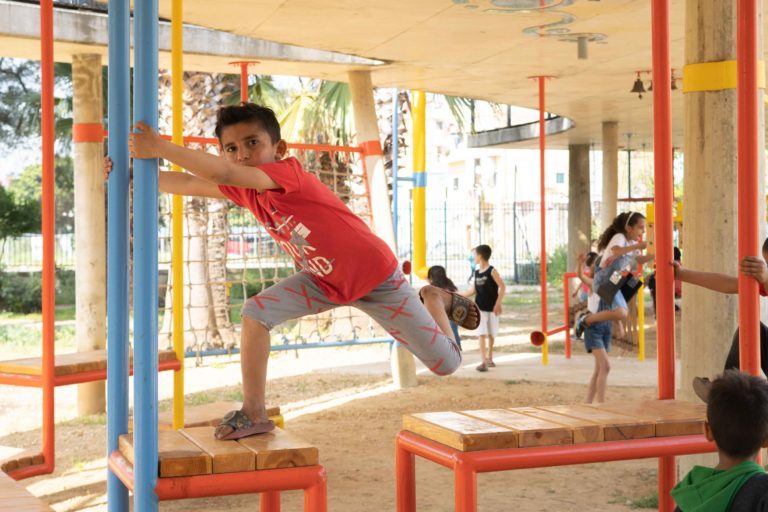Key messages
Displacement is at a world record high as a result of persecution, conflict, violence, and human rights violations. Children make up around half of the refugee population worldwide, and 40% of the 80 million displaced people globally. Approximately two-thirds of displaced people live in urban areas, the large majority in developing countries (UNHCR 2020). The quality of spaces available to children has an important impact on child development and wellbeing as it affects a number of children’s rights including play, health, safety and learning.
Co-designing built interventions with children affected by displacement can:
- empower children and have a lasting positive impact;
- improve social cohesion, inclusion, social capital, and integration between refugee and host communities, and within the refugee community;
- have a positive impact on the local economy, build capacity and provide employment; and
- deliver better social infrastructures (child-friendly urban public spaces, including open public spaces, streets and public facilities such as schools and playgrounds) for children and their communities.
Despite their impact, there is an undersupply of built interventions that have been co-designed with children. This is because: they require professionals from different specialisms to work together, and often organisational structures do not make these collaborations easy; their additional value is difficult to recognise; and they require a larger initial investment compared to the built product alone. Furthermore, these interventions often present multiple operational challenges linked to safeguarding, cultural norms and appropriateness. This prevents many organisations from taking on such projects, despite the strong need for children’s voices to be part of design responses in displacement contexts.
The DeCID handbook was born out of a lack of practical guidelines for co-designing built interventions with children affected by urban displacement. It was created by a mixed team of practitioners and academics from different disciplines, and via a research process involving interviews and thematic discussions with varied related practitioners.
This handbook aims to raise the number and quality of built interventions that have been co-designed with children affected by displacement in the urban context: ultimately advancing their wellbeing. It provides practical insights regarding interventions that put children’s wellbeing first, and at the intersection of participatory design, forced displacement, and the urban context.

Starting up: from idea to partnership
Ideas originate in a variety of ways and from different actors.
Children must be at the centre of developing ideas for interventions.
Children and their communities must be considered partners in interventions.
As built interventions co-designed with children require different functions, roles and capacities, complementary actors need to work in partnership.
The expertise required draws upon different disciplines, but should find a common language.
Translating children’s ideas into design solutions
In-depth knowledge of the local context and needs enables practitioners to develop context-appropriate interventions.
Children must be at the centre of the co-design process.
The process of designing spaces with children requires careful planning and the preparation of tools appropriate to the context and the participants.
The process must equip children with the knowledge needed to fully participate.
A careful and participatory selection of sites for interventions is essential for ensuring their positive impacts on children and long-term sustainability.
The choice of materials and technologies can generate positive impacts and empower the local community.
Purchasing materials locally, hiring local labour and adopting context appropriate technologies can help boost local economies and improve social cohesion.
The technical design should enable the hiring of local labour and children’s participation during the construction phase.
Procurement and building
- Procurement and site supervision must guarantee the safety and wellbeing of workers and children.
- Carefully planned procurement can boost the local economy, improve livelihoods and social cohesion.
- It is important to work with contractors and suppliers to develop context appropriate procedures for managing building works.
- Building with children and communities is an empowering experience that requires careful planning.
Post building, impact, and sustainability
Full ownership of a space by children and their communities, as well as a clear management structure involving relevant stakeholders (e.g. local government), contribute to long-term sustainability.
Careful design and procurement reduce costs and the need for maintenance, as skills and materials are available locally.
Built interventions co-designed with children make an impact through both their physical output and implementation process.
The value for money of co-designed built interventions must be assessed by considering the multiple short- and long-term impacts, including the social impact of the process itself.
The allocation of adequate time and resources for evaluating interventions and their long-term impact can contribute to learning.
Children and their communities must be part of the evaluation process.

